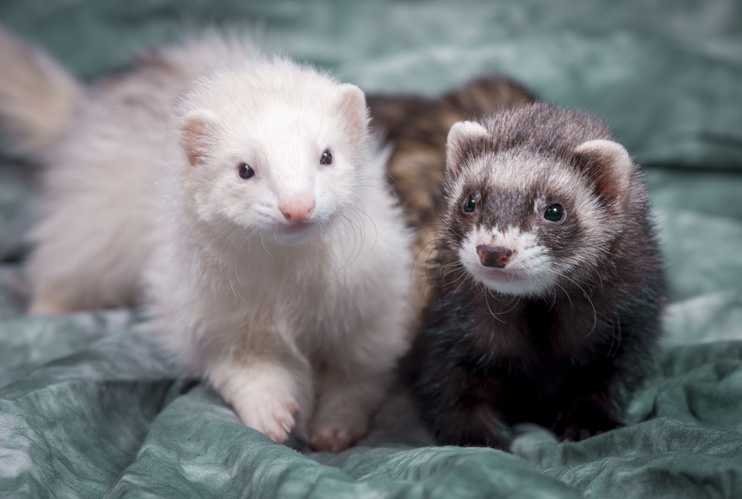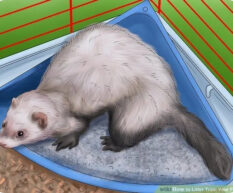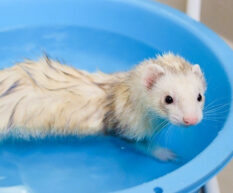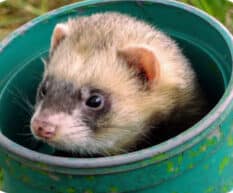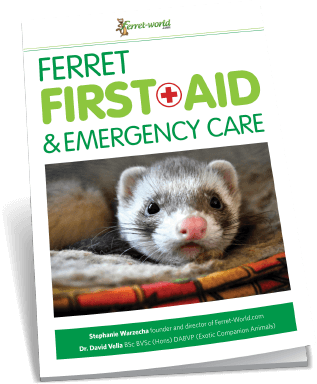Ferret News
Ferret kibble: breaking down what’s in the bag. Is it nutritionally sound?
By Adriane Whelchel
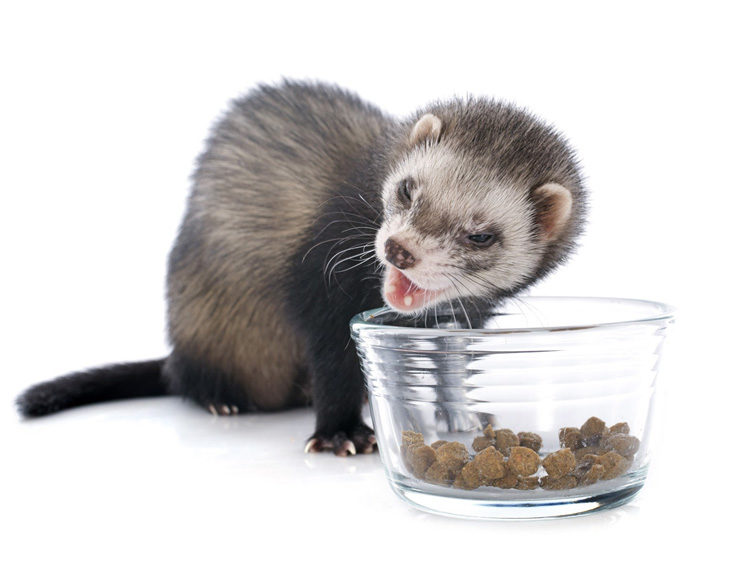
There have yet to be any science-based feeding trials to determine the precise nutritional requirements of the ferret. Ferret feeding recommendations are based on what we know about ferret biology, ferret diseases, and ferret relatives like mink. When deciding which kibble is best to feed ferrets, it’s very important to understand them and how their digestive system works.
Ferrets are obligate carnivores: they are meat eaters and they require a diet that is based on meat. They need to avoid plant-based foods as much as possible. Nutritionally, the best ferret diets are high in protein and fat and low in fiber and carbohydrates. They have a relatively simple and short digestive tract, lacking a cecum and an ileocolic valve. This simplicity and short length account for the quick movement of food through their system, only 3-4 hours, and therefore they need to eat easily digestible food to get the necessary nutrients their bodies need.
Nutrients are split into two groups: macronutrients (protein, fat, and carbohydrates) and micronutrients (vitamins and minerals). The lower quality kibbles generally have a good balance of the micronutrients; it’s the macronutrients where kibbles tend to fall short.
Breaking down the ingredient list of ferret kibble
Generally, the first five ingredients in the ingredient list make up the majority of our ferret’s kibble. In the United States, the Food and Drug Administration (FDA) requires that all of the ingredients be listed in order by weight from most abundant to least. Many other countries also follow this guideline.
The weight of the ingredients includes their inherent water content, and this is very important to remember when looking at an ingredient list.
For example, if the first ingredient in a kibble is 15 ounces of chicken and the second ingredient is 14 ounces of cornmeal, this kibble could advertise itself as being a “meat first” pet food. Before processing 70% of the chicken’s weight is water and 10% of the cornmeal’s weight is water. After cooking, the 15 ounces of chicken have become 4.5 ounces of chicken and 14 ounces of cornmeal have become 12.6 ounces. Using dry weights, the cornmeal now makes up most of the kibble and is the primary source of protein.
If this were a ferret kibble, it would be unsuitable for our furry friends because cornmeal is a plant-based protein and shouldn’t be a primary protein source for an obligate carnivore.
Plant-based proteins are poorly digested by ferrets; they can’t break them down to meet their nutritional needs. The best digestible protein sources are specified meats and specified meat meals; look for them in the top five ingredients of kibble. Following those ingredients, look for specified meat byproducts (such as organs), eggs and gelatin, meat protein isolate, specified animal oils, and specified animal fats.
Protein found in ferret food
Protein is vital to a ferret’s diet; it provides the essential amino acids for them to be healthy and strong. How much protein should be in that bag of kibble we are giving to our furry mischief-makers?
At least 35% protein should be in their kibble, but that number doesn’t tell the whole story. Ferrets need meat-based protein. Plant-based proteins are a poor choice for ferret kibble because ferrets don’t digest them well and they don’t always provide all the amino acids needed for good health.
It’s important to choose a kibble that is plentiful in meat-based ingredients to provide protein. Try to avoid kibbles that are made with less expensive plant-based foods. For ferrets, plant-based ingredients provide little to no nutritional value and will only help give that bag of kibble an increased crude protein percentage.
Common meat-based ingredients found in ferret kibble: chicken meal and chicken
I reviewed the top five ingredients in 50 ferret-specific kibbles. Out of those 50, only seven did not list a plant-based protein in the top five ingredients. Chicken meal was the most common meat-based ingredient, found in 54% of the kibbles I analyzed. The Association of American Feed Control Officials (AAFCO) defines chicken meal as “the dry rendered product from a combination of clean chicken flesh and skin with or without accompanying bone, derived from whole carcasses of chicken, exclusive of feathers, heads, feet, and entrails”. The AAFCO has no regulating authority over pet food. It writes different model bills regarding pet food and animal feed, and one of those bills contains the legal definitions of all pet food and animal feed ingredients, which the FDA recognizes. Other common meals are turkey, poultry, and fish meal.
Chicken was the second most common meat-based ingredient, found in 44% of the 50 kibbles. Chicken byproduct meal and poultry byproduct meal are other common meat-based ingredients found in ferret kibble. Byproduct meal, as defined by the AAFCO, is “the dry, ground, rendered, clean parts of the slaughtered carcass, such as necks, feet, viscera (esophagus, heart, liver, spleen, stomach, crop, gizzard, undeveloped eggs and intestines), and whole carcasses, exclusive of feathers except in such amounts that may occur unavoidably in good processing practices”. Byproduct meals are a controversial ingredient because of their ingredient inconsistency and questionable nutritional value.
Other highly digestible ingredients and good sources of protein I came across were eggs, gelatin, and meat protein isolate; the last two were not found in many of the kibbles I examined. Gelatin comes from the collagen found in animals and contains more than 80% protein. Gelatin is also a food-binding agent in meat-based pet foods. Meat protein isolate is made by separating meat protein from bones through heat processing and then low-temperature drying for nutrition preservation.
The nonspecific ingredient term “meat” raises red flags to some pet owners because the product is coming from an unnamed source. When a food ingredient does not list a specific animal source and instead uses the generic term “meat”, according to the FDA and the AAFCO, that ingredient can only come from the following: cattle, swine, sheep, or goats.
Common plant-based ingredients found in ferret kibble: white rice and corn gluten meal
There were 43 kibbles out of the 50 that had at least one plant-based food listed within their top five ingredients. More specifically, there were 23 that contained one plant-based food, 15 had two listed in the top five, four kibbles had three plant-based proteins, and there was even one where four out of the five listed ingredients were plant-based foods.
These are ingredients ferrets cannot digest easily, so they are not particularly beneficial. The most common plant-based food was rice and unless otherwise specified, rice in an ingredient list is white rice. Rice is considered a high carbohydrate food and a protein contributor. It was found in nine different kibbles and listed as high as the second ingredient in four of those kibbles. Rice is a grain, it isn’t that high in protein, it’s high in carbohydrates, and the ferret’s digestive system cannot process it well.
The next most common plant-based food was corn gluten meal (sometimes labeled as maize gluten meal or prairie meal); it was found in five kibbles. Corn gluten meal is 60% protein and one of the highest plant-based proteins in kibble. But again, as a plant-based protein, corn gluten is not a good choice for ferrets because they cannot digest it well. Despite its name, it has no true gluten and it is also a food binding agent. Brown rice, ground corn, brewers rice, cornmeal, dehulled soybean meal, and corn (sometimes labeled as maize) were the next most common.
All of these ingredients are grains, grain byproducts, or grain-derived. These ingredients are higher in carbohydrates and they’re not very high in protein, except dehulled soybean meal which is 49% protein. Other plant-based foods that were commonly found in the top five of the ingredient list were potato starch and dried plain beet pulp (sometimes labeled as sugar beet, beet pulp, or dried beet pulp). Potato starch was in five kibbles. It is only a starch and offers no nutritional value. It’s used as a binding agent in kibbles, especially in ones labeled as grain-free.
Dried plain beet pulp is the byproduct left over after the removal of raw sugars from sugar beets. It’s a source of fiber used to add bulk and moisture to stool and was found in eight kibbles. The following are categorized as plant-based proteins according to the 2020 AAFCO Official Publication and can be found in ferret kibble: peas, potato protein, dehulled soybean meal, soy flour, linseed meal (sometimes labeled as flaxseed meal) and brewers dried yeast.
Fats found in ferret kibble
Ferrets need a diet that is high in fat. Unlike other mammals, they are unable to use carbohydrates as an energy source. The majority of their dietary energy is provided by fats.
The text Ferrets, Rabbits, and Rodents: Clinical Medicine and Surgery and the British Ferret Club both say if a ferret is fed a dry diet, then the fat content should be 15%-20%. The text Biology and Diseases of the Ferret says the fat content of ferret kibble should be 18%-30%, and the American Ferret Association says it should be approximately 20%. On the guaranteed analysis, crude fat is listed as the minimum amount in the kibble and it should contain 15%-30% crude fat.
For ferrets, fat is good, but if the diet is too high in fat, that may cause the ferret to eat less and become deficient in other necessary vitamins and minerals. The best fat sources to look for in ferret kibble are specified animal fats and oils.
Chicken fat and poultry fat were the most common fat sources I found amongst the 50 kibbles that were reviewed. They are good ingredients to see as the third, fourth or fifth ingredient listed. Vegetable oil is even acceptable but should be further down the ingredient list with a specified animal fat being the primary fat source.
Fiber and carbohydrates found in ferret food
If your ferret lived her life out in nature, as an obligate carnivore, the only sources of fiber and carbohydrates she would consume would be what is found in the gut of her prey. Ferrets cannot digest complex carbohydrates, and that includes fiber. If they are fed a diet too high in fiber, it can interfere with the digestion of nutrients and can cause a protein-calorie deficiency.
Fiber content has to be listed in the guaranteed analysis as the maximum amount contained in the kibble and should not exceed 5%.
Ferrets that are fed a diet high in carbohydrates are at an increased risk of developing serious health issues and diseases like reproductive issues, an impaired immune system, metabolic problems, or insulinoma
Examples of foods that are high in complex carbohydrates and should be avoided are fruits, oats, brown rice, potatoes, soybeans, peas, sweet potatoes, and wheat. The amount of carbohydrates a kibble contains does not have to be listed, but it is an important value to know. The lower the carbohydrate content in kibble, the better. In her scholarly article on ferret nutrition, Judith A. Bell recommends a carbohydrate content of less than 30%.
Estimating the carbohydrate content
PROTEIN + FAT + FIBER + CARBOHYDRATES + ASH + MOISTURE = 100%
The total weight of a pet kibble is the sum of the percentages by weight of protein, fat, fiber, carbohydrates, ash, and moisture. The sum must always add up to 100. Look to the guaranteed analysis to fill in the blanks for these numbers.
In the guaranteed analysis, the protein, fat, fiber and moisture content will be found. These components are required to be listed by the FDA. In the US, it is up to the food manufacturer if they want to include the ash content. “Ash” is what remains after the food has been burned and mainly consists of bone fragments and the minerals calcium, phosphorus, and magnesium.
If the ash content is not listed, 8% ash is a good number to use. The ash in most ferret kibble ranges from 6%-10%. On some kibbles from other countries besides the United States, the ash content is listed but the moisture content is not. The moisture content in most kibbles is 10%, so that is a reasonable number to use if moisture is not otherwise listed. To get a good estimate of a kibble’s carbohydrate content a simple math formula can be used.
CARBOHYDRATE = 100% – PROTEIN – FAT – FIBER – MOISTURE – ASH.
Here is an example using that formula to find the estimated carbohydrate content in Wysong Epigen 90 Digestive Support. The guaranteed analysis for that kibble reads: Crude Protein 62%, Crude Fat 16%, Crude Fiber 5%, and Moisture 10%. The ash content is not given, so we’ll use 8%. Using those numbers, estimated carbohydrate content = 100% – 62 – 16 – 5 – 10 – 8. That equation equals -1, but the carbohydrate content of any kibble cannot be a negative number. If the answer does come out to be a negative number, that means the carbohydrate content of that kibble is very little.
This equation does not provide an exact amount; it’s only an estimate. I spoke with a representative at Wysong and they told me that Wysong Epigen 90 Digestive Support has a carbohydrate content of 2.7%. This number is consistent with our -1% as an indicator that this food is very low in carbohydrates.
Here it’s useful to remember that the crude fiber and moisture percentages listed in the guaranteed analysis are maximum values, not necessarily the actual values. If fiber is included as a carbohydrate, then 5% + -1% = 4% carbohydrates, a value which is pretty close to the number Wysong provided to me. But carbohydrate content could be as high as 7.7% if we add fiber to the 2.7% carbs that Wysong reports.
The good news is that all of these numbers suggest this kibble is low in carbohydrates, which is ideal for ferrets. It would be easier if pet food manufacturers listed all of this information in the guaranteed analysis. Since they don’t, it’s good to know consumers have a way to get a close estimation.
Looking at 50 different ferret-specific kibbles manufactured from different countries across the world made it much clearer to me that a truly outstanding ferret kibble can be tricky to find. The better kibbles out there are more costly because they use meat-based ingredients instead of cheaper plant-based ones.
However, it seems like there will always be at least one ingredient in them that makes the lover of fuzzies scratch their head and wonder if it is alright to feed their little ones. The top five ingredients are a good place to start but they don’t tell the full story of a ferret kibble’s recipe. Young Again Ferret Food and Pretty Pets Natural Gold Ferret Food are two decent kibbles that can be recommended for ferrets, but the third ingredient in both of those is potato starch.
Potato starch offers no nutritional value and is the ingredient used to hold the food together. The remaining ingredients in the bag, however, are fine for ferrets. The US-made Wysong Epigen 90 and Wysong Epigen 90 Digestive Support and the German-made Frettchen4you rEVOLUTION are three good kibbles for ferrets.
There are more good kibbles out there; it just takes some guaranteed analysis and ingredient list investigation to find. As ferret owners, the best we can do is become educated on what’s good versus what’s not. We want to give them the best food available so they can live long, healthy lives and continue to grace us with their love, dooks, and mischief.
Further reading
Bell, Judith A. “Ferret Nutrition”. Veterinary Clinics of North America: Exotic Animal Practice, volume 2, issue 1. Published in 1999. Pages 169-192. (Scholarly article)
“The Business of Pet Food.” AAFCO. https://petfood.aafco.org/Nutritional-Labeling. Accessed 28 February 2020. (Web page)
Johnson-Delaney, Cathy A. “Ferret Nutrition”. Veterinary Clinics of North America: Exotic Animal Practice, volume 17, issue 3. Published in 2014. Pages 449-470. (Scholarly article)
If you enjoy this article on ferret food you may also enjoy reading:

